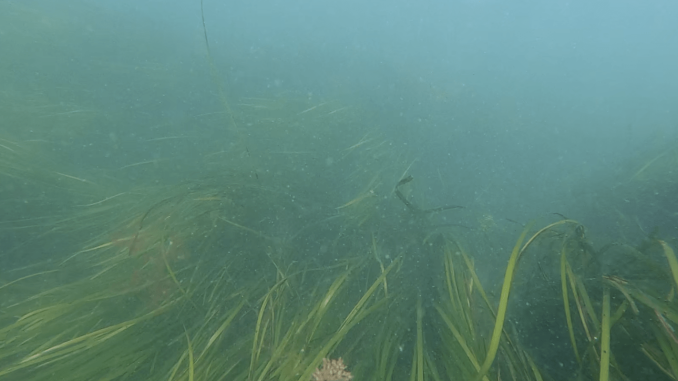
In early August, Emma DeLoughry of Save the Sound and Rob Vasiluth of SAVE Environmental dove into Long Island Sound off of Fishers Island and collected eelgrass seed pods, completing phase one of a major eelgrass restoration project for the Sound.
“It should matter to all people that live along the water or have an income from the water,” Mr. Vasiluth said. “When you restore eelgrass, it rapidly brings back fish stocks which is good for recreational fishermen, commercial fishermen and for the species of fish that it’s helping.”
Mr. Vasliuth is an operating engineer and the founder of SAVE Environmental. He founded the company three years ago and has a patent on growing eelgrass with shellfish by attaching eelgrass seeds to them. Ms. DeLoughry has been Save the Sound’s Soundkeeper Associate since June and worked with them last summer as part of their Melissa J Schlag Intern for Justice and the Environment program.
Eelgrass is submerged aquatic vegetation. According to The Nature Conservancy, there is only 10%, or 2,000 acres, of eelgrass left in the Sound. There is a myriad of benefits to restoring it in Long Islands waters.
According to the National Oceanic and Atmospheric Administration, Eelgrass provides numerous important ecosystem functions, including foraging areas and shelter to young fish and invertebrates, food for migratory waterfowl and sea turtles, and spawning surfaces for species such as the Pacific herring. Eelgrass beds also help reduce coastal erosion by trapping sediment, stabilizing the substrate, and reducing the force of wave energy.

The National Oceanic and Atmospheric Administration says the plant also improves water quality by filtering polluted runoff, absorbs excess nutrients and stores greenhouse gases like carbon dioxide.
“It’s a really critical species in the Sound for helping our wildlife and just for the sound health in general,” Ms. DeLoughry said.
According to Save the Sound, Fishers Island’s eelgrass meadows make up nearly 25% of the seagrass that remains in the entirety of the Long Island Sound.
The first phase of the project was the collection, Ms. DeLoughry and Mr. Vasiluth dove three times over the summer, once on July 28, and twice on August 3. They collected adult stalks of eelgrass from the eelgrass meadows. According to Save the Sound, their haul collected over 80,000 seeds from the stalks. They are being preserved at Cornell Cooperative Extension in Southold.
Mr. Vasiltuh said that they went to Fishers Island because it has the best production of eelgrass seeds anywhere in New York.
“The viability of those seeds is around 20% whereas seeds taken from the South Shore, they’re about 10% viability,” he said. “It takes a lot longer to collect that amount of seeds by far because the plants on the South Shore don’t produce as many seeds as what we get out of Fishers Island.”
The next phase of the project is to literally glue those seeds to clamshells. Five seeds will be glued to each clamshell between 18 and 30 millimeters in size, according to Save the Sound. Mr. Vasiluth will be getting around 20,000 hatchery clams from the Great South Bay Shellfish Cultivation Facility in Islip. Phase three would be deploying the clams across a two-acre area of Smithtown Bay.
“We’re hopeful that the clams will burrow themselves in the sand, and then that way to plant the eelgrass seeds,” Ms. DeLoughry said.

The goal is to have up to 20,000 plants take root. Then two years later when the surviving plants are expected to reach maturity, they expect the new plants will produce 100-200 blades of grass and then produce its own seeds.
This project has been a favorite of Ms. DeLoughry because of its hands-on nature.
“It has the potential to be somewhat revolutionary in the way that, worldwide, we can be replanting eelgrass meadows, so I think it’s got really strong potential and it’s a great project.”
According to Ms. DeLoughry, they received a grant from the 11th hour project, to film the process. The 11th hour project, also known as The Schmidt Family foundation, established in 2006, supports qualifed 501(c)(3) organizations and social enterprises through grantmaking, impact investing and complementary resources according to their website.Save the Sound has a video on their website which documents their journey completing phase one. There will be more to come as they embark on the following phases of the restoration project.
Mr. Vasiluth said he plans to start gluing seeds to clams at the end of this month.
Mr. Vasiluth has been going to various school districts across the island and showing students his method of regrowing eelgrass which he really enjoys.
He said the biggest challenge with this project has been funding and he’s open to receiving volunteers. If you’d like to donate or volunteer, you can contact Mr. Vasiluth at [email protected].

Be the first to comment